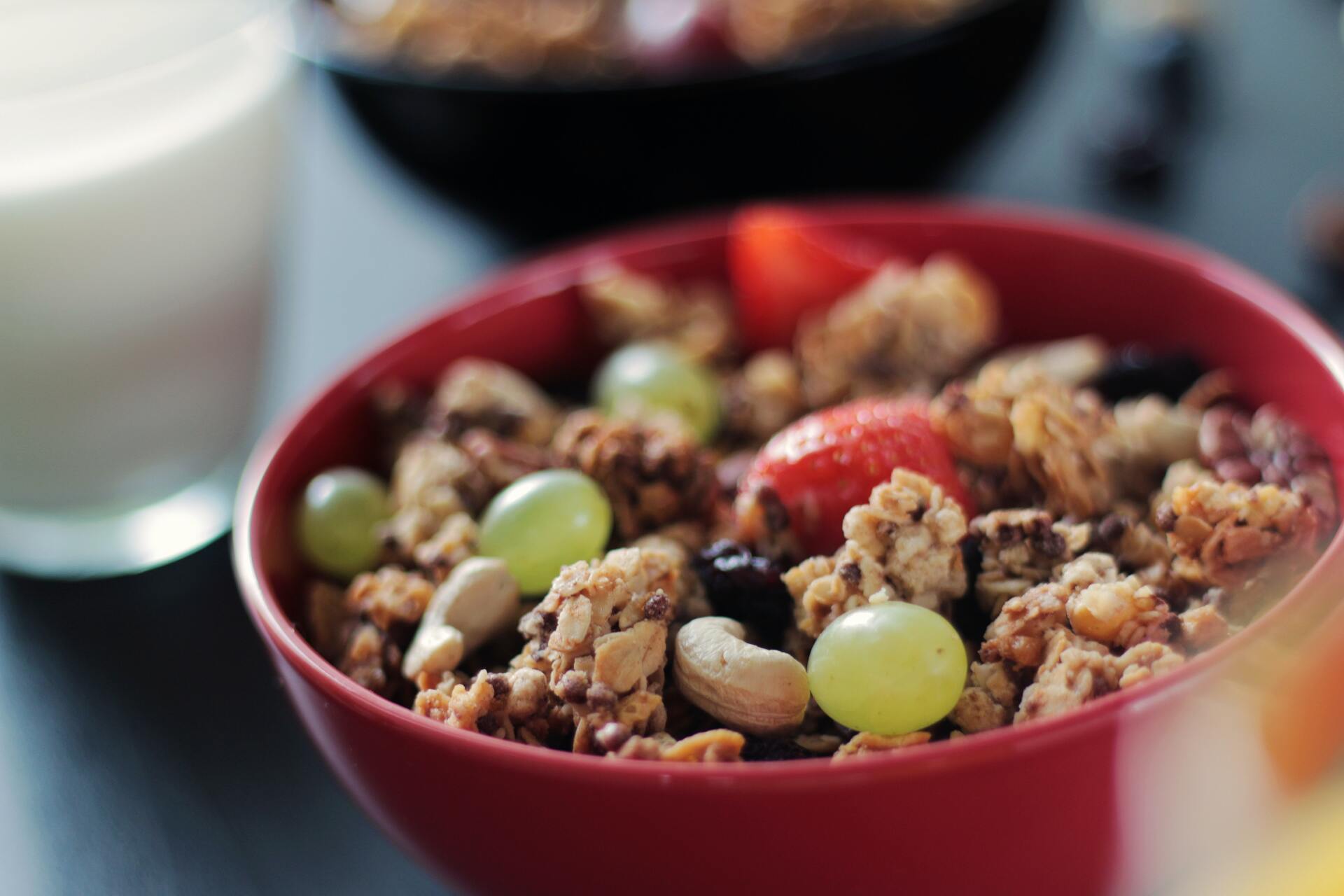Fiber -- what's the big deal?
Fiber -- what's the big deal?
Fiber, a natural component of plant-based foods, is a type of carbohydrate that our bodies can’t digest or absorb, what used to be referred to as “roughage”. It slows down digestion and helps to pass food waste more efficiently through the body, promoting bowel regularity. It is found mainly in fruits, vegetables, whole grains, and legumes.
You may have heard of the many health benefits of dietary fiber:
- appetite and weight control,
- enhanced nutrient absorption,
- better blood sugar control,
- Type 2 diabetes prevention,
- reduced inflammation,
- enhanced immune function,
- protection against inflammatory bowel syndrome,
- possible prevention of intestinal cancer,
- constipation relief, and
- healthier gut microbiota.
Adding to that, researchers have recently found that higher intake of fiber from cereals, in particular, is associated with lower risk of cardiovascular disease.
That gets it over the line for us – sign us up for more fiber! So … where to start? Since most of us don’t get enough fiber in our diet, let’s revisit the types of foods that are good sources of fiber, but first, here are a few quick tips:
Tip 1: Check with your doctor or pharmacist
Always check with your doctor or pharmacist before making big (even gradual) changes to your diet and before taking fiber (or other) supplements. They can advise on possible interactions with medications, interference with their absorption, or interference with their effectiveness, and provide suggestions that work for your particular situation.
Tip 2: Go slow
When a person suddenly increases their fiber intake dramatically, they may get side effects such as intestinal gas, bloating, constipation, nausea, diarrhea, and cramping. So they stop having fiber-rich foods and forgo the benefits.
The trick is to increase fiber intake slowly, over a few weeks, so that the natural bacteria in your digestive system has time to adjust. Make incremental changes on the way to a more fiber-friendly diet.
Tip 3: Drink 8 cups of water
Fiber works best when it absorbs water, so it is also important to drink plenty of fluids when increasing fiber intake. Recommendations vary (8 to 10 cups per day for males and 8 to 9 cups per day for females) and each person is different. As a rule of thumb, having urine that’s straw colored or lighter (except first thing in the morning) is a sign that you’re getting enough fluid.
Tip 4: Get fiber from food first before adding a supplement
Food provides a mixture of micronutrients, vitamins, minerals, phytochemicals, satisfaction of the taste buds, the feeling of fullness, and likely other things that we don’t yet understand that are absent in supplements. Our bodies appreciate all those other elements and it’s all the better if we don’t need to take a fiber supplement.
Tip 5: Older adults benefit from fiber
Inflammation and constipation, two conditions that a healthy diet including fiber can help with, tend to be more prevalent in older adults than in other age groups. All the more reason to increase fiber intake and/or to let a loved one know about its benefits.
Tip 6: Don't overdo it
While most of us don’t get enough fiber, some of you may. Here’s what’s recommended, per day:
- for men aged 50 or younger – 38 grams
- for men aged 51 or older – 30 grams
- for women aged 50 or younger – 25 grams
- for women aged 51 or older – 21 grams
Getting too much fiber is possible and the effects are not pleasant. Intestinal blockage, rare but serious, can occur with a high fiber diet where not enough fluid is consumed.
What foods are good sources of fiber?
The following list provides a sample of foods high in fiber. Choose a few that you enjoy and switch it around after a week or so, for variety!
Legumes – beans, dried peas, lentils, pinto beans, kidney beans, lima beans, garbanzo beans, etc. Legumes are also a good source of protein.
Whole grains – whole wheat breads and pastas, brown rice, bran cereals, rolled oats, barley, oatmeal, popcorn, etc.
Fruits – raspberries, pears, blueberries, strawberries, bananas, apples, pears, peaches, prunes, avocado, etc. Fruit eaten with the skin on are especially good.
Vegetables – broccoli, cauliflower, carrots, spinach, potatoes, sweet potatoes, string beans, peas, kale, etc.
Nuts and seeds – chia seeds, flax seeds, pumpkin seeds, almonds, pistachios, pine nuts, chestnuts, sunflower seeds, etc. Keep in mind that nuts and seeds are also good plant-based sources of omega-3 fatty acids, which have heart-protective effects. Plus, their high fat content can help you feel fuller longer.
Animal products don’t naturally contain fiber, but fiber can be added during processing and you can see the quantity on the food label.
Ongoing research
Finally, scientists are exploring and working further on the categorization of dietary fibers. Traditionally split into “soluble” and “insoluble”, they are finding that other factors come into play; for example, fermentability, viscosity, tolerability, and prebiotic activity.
While waiting for further research results, we’ll take out insurance by increasing the fiber in our diet slowly!
References and Additional Information:
- Columbia University on how cereal fiber is linked with lower inflammation - https://www.publichealth.columbia.edu/public-health-now/news/not-all-dietary-fiber-created-equal-cereal-fiber-linked-lower-inflammation
- Journal of Animal Science and Biotechnology on the classification of fiber - https://jasbsci.biomedcentral.com/articles/10.1186/s40104-019-0350-9
- American Heart Association on needing more fiber in our diet - https://www.heart.org/en/news/2022/01/27/sound-the-fiber-alarm-most-of-us-need-more-of-it-in-our-diet
- Duke University on practicalities of increasing fiber in diet - https://studentaffairs.duke.edu/sites/default/files/u110/TooMuchFiber082015.pdf
- National Library of Medicine on the Effects of Dietary Fiber and Its Components on Metabolic Health - https://www.ncbi.nlm.nih.gov/pmc/articles/PMC3257631/
- Australian government on high fibre foods - https://www.healthdirect.gov.au/high-fibre-foods-and-diet
- Scientific American and Monica Reinagel on types of fiber and their benefits – https://www.scientificamerican.com/article/fiber-2-0-fibers-new-science-of-health-boosting-benefits/ and https://www.quickanddirtytips.com/health-fitness/healthy-eating/new-fiber-benefits?utm_source=sciam&utm_campaign=sciam
- U.S. News & World Report – on types of fiber and how to integrate fiber into our diet - https://health.usnews.com/health-care/patient-advice/articles/what-is-fiber-and-how-you-can-get-enough
- Academy of Nutrition and Dietetics on ways to boost fiber - https://www.eatright.org/food/vitamins-and-supplements/types-of-vitamins-and-nutrients/easy-ways-to-boost-fiber-in-your-daily-diet
- UCSF on how to increase fiber intake - https://www.ucsfhealth.org/education/increasing-fiber-intake
- Cleveland Clinic on the fiber content of common foods - https://my.clevelandclinic.org/health/articles/14400-improving-your-health-with-fiber
- Harvard School of Public Health on types of fiber - https://www.hsph.harvard.edu/nutritionsource/carbohydrates/fiber/
- Mayo Clinic on nutrition and healthy eating, and on whole grains – https://www.mayoclinic.org/healthy-lifestyle/nutrition-and-healthy-eating/in-depth/fiber/art-20043983 and https://www.mayoclinic.org/healthy-lifestyle/nutrition-and-healthy-eating/in-depth/whole-grains/art-20047826
- Duke University on high-fiber diets - https://studentaffairs.duke.edu/sites/default/files/u110/TooMuchFiber082015.pdf
- Oklahoma State University on dietary fiber - https://extension.okstate.edu/fact-sheets/dietary-fiber.html





